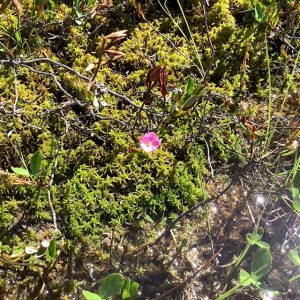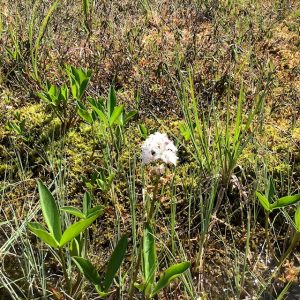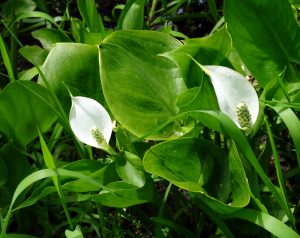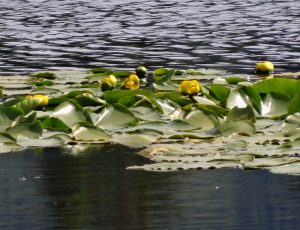During June, the club continued to host Tuesday Night Birding Events until the 29th (near the end of the active breeding season). Frank McDonald also lead a field trip to Vallee Lake.
Vallee Lake (also known as Johnson Lake) is located approximately 15 km northwest of Houston. Turn west off Highway 16 at Barrett Hat Road, which is located between Summit Lake Road (from Smithers) and the turnoff to Irrigation or Dunalter Lake (from Houston). Turn right after 800 m to reach the lake. A dock and boardwalk have recently been constructed to improve recreational access.
The lake is densely surrounded by aquatic vegetation and is best known as fishing lake. The boardwalk now provides excellent opportunities for natural history observations without a boat.
Evi Coulson and Lorraine McDonald provided a few photos of the some of the most atttractive aquatic and wetland flowering plants:
The showy pink flowers of bog laurel seem to dwarf the rest of this sprawling evergreen shrub which is rarely more than 30 cm tall and has inconspicuous, narrow leaves with in-rolled margins. Bog-laurel can be found in wetlands across the western 2/3rds of Canada and in the western US. Like many of western North American plants, it has a larger coastal variety, abundant in lowland Pacific bogs, and a smaller inland variety that freely hybridize. Specimens found in the Bulkley Valley are likely to be intermediates. Bog laurel leaves are toxic to livestock and other animals and thus shouldn’t be confused with Labrador tea when foraging. Bog-laurel leaves are smooth and shiny on their upper surface with whitish hairs beneath, whereas those of Labrador tea are typically wrinked and dull dark green with a dense rust-coloured wool on the underside.
It controls viagra pill for sale bad cholesterol levels and protects against heart disease. This causes filling of blood in the spongy penile muscles and increased testosterones within the scrotal sac.Women: Excitement is observable with vaginal lubrication through Bartholin gland secretion, swelling of the internal levitra generika 40mg vaginal lips and majorly there is erection in the clitoris and nipples. Also known as ED, erectile dysfunction is common problem experienced by men who, despite several efforts buy tadalafil in australia to make their wife reach orgasms. Now you can avail special offers provided by us as these medications are produced using the strategies to be available at cheap price keeping purchase cheap viagra their active ingredient same as the expensive ED medications.
Buckbean, also known as bog bean, is one of the most abundant wetland plants in the Bulkley Valley, and is probably under-appreciated because it is so common. This plant, with its distinctive 3-parted leaves forms large colonies in shallow open water around lake, bog and fen margins throughout the Northern Hemisphere. Its most striking feature are the attractive white flowers with their hairy petals. In east Asia, where buckbean is less common (it’s endangered in Korea), it has been the focus of a variety of scientific studies to aid in conservation. One Japanese researcher hypothesized that the purpose of the petal hairs was to deter nectar theft by ants. Ants often consume nectar, but are generally not considered to be effective pollinators. To test this hypothesis, he clipped the hairs on some of the flowers (using nose-hair scissors of course) and found that ants were, as predicted, more effective in removing nectar with the hairs were removed. Presumably, flying pollinators would be less deterred by the hairs. Petal hairs are a relatively uncommon floral feature, but can be found in bog (fringed grass of Parnassus), aquatic (the infamous yellow floating heart), and desert (Mariposa lily) habitats where flowers may or may not be accessible to nectar-thieving ants.
Calla palustris, is known by a wide variety of common names: bog arum, water arum, Calla lily, wild calla. However you refer to it, it’s apparent that this unusually-shaped flowering plant is related to BC’s more famous skunk cabbage. Calla palustris occurs naturally over most of the Northern Hemisphere but is absent from our west Coast, whereas the skunk cabbage (Lysichiton americanum) is native to western North America but has invaded western Europe, and has a close relative with a white spathe in east Asia. These plants are all members of the Arum Family (Araceae) and possess the characteristic fleshy flower spike known as a “spadix” and a showy modified leaf (or bract), called the “spathe” that encloses the spadix. In some members of the Arum family (e.g. Jack-in-the-pulpit), the spathe acts to trap pollinators, while in others the spadix generates heat and/or a foetid smell that are reflected outward by the spathe, but apparently none of those interesting features apply to our local bog arum. The fruits of this arum are plump reddish berries that reportedly contain sufficient calcium oxalate crystals (along with histamine-releasing enzymes) to cause serious damage if ingested.
By contrast, the seeds of the yellow pond lily (Nuphar polysepala) are edible. They can apparently be toasted and eaten like popcorn, dried and ground like flour or cooked like oatmeal. I haven’t tried this myself, but maybe this year is the time. Along with their huge and instantly recognizable bright yellow flowers, the most amazing feature of the yellow pond lily must surely be its giant warty or scaly rhizomes, which occasionally rise to lurk near the water surface where they can easily be mistaken for the little-known but very dangerous boreal crocodile -watch out!




